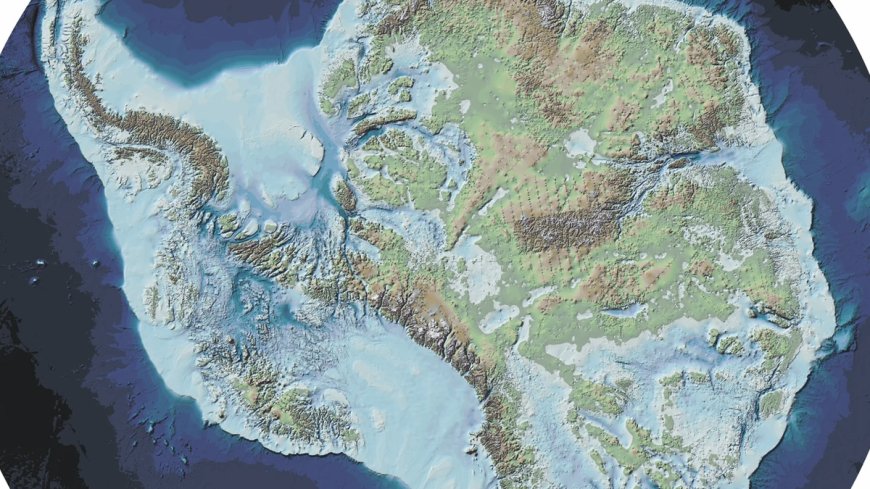Data reveals birth of Antarctica’s hidden mountain range 500 million years ago

Asarkari - Sarkari News, Jobs & Updates
Data Reveals Birth of Antarctica’s Hidden Mountain Range 500 Million Years Ago
By Meera Iyer
Date: October 26, 2023
Summary
kam sabdo me kahein to, new research using advanced subglacial imaging techniques has uncovered evidence of a massive, previously unknown mountain range beneath Antarctica's ice, formed around 500 million years ago during the assembly of the supercontinent Gondwana. This discovery offers crucial insights into the continent's geological past and its role in global tectonics.
Introduction
Antarctica, the icy continent at the bottom of our world, continues to surprise us with secrets buried deep beneath its frozen expanse. In a groundbreaking revelation, scientists analysing a wealth of geophysical data have announced the discovery of a vast, ancient mountain range, hidden for eons under kilometres of ice. This colossal geological feature, comparable in scale to some of Earth's major mountain systems, is believed to have formed approximately 500 million years ago, offering a stunning glimpse into a turbulent period of Earth's history.
Unveiling the Ghosts of Gondwana
The newly identified mountain range, tentatively named the "Gamburtsev Subglacial Ghost Mountains Extension" by some researchers involved, though an official name is pending, lies in a remote sector of East Antarctica. Its existence was pieced together through meticulous analysis of ice-penetrating radar data, aeromagnetic surveys, and seismic soundings collected over several decades by international research expeditions. These techniques allow scientists to peer through the thick ice sheet, which in some areas is over three kilometres deep, to map the bedrock topography below.
The data suggests that these mountains were once majestic peaks, potentially rivaling the European Alps in their heyday. Their formation dates back to the late Cambrian or early Ordovician period, a time when the supercontinent Gondwana – comprising present-day Antarctica, South America, Africa, Australia, India, and the Arabian Peninsula – was assembling. The immense tectonic forces involved in this continental collision are believed to have buckled and uplifted the Earth's crust, giving rise to this extensive mountain system.
“Imagine a landscape as dramatic as the Himalayas, but completely entombed in ice. That’s what we’re looking at,” explained Dr. Lena Hansen, a lead geologist on the international project, not affiliated with Asarkari. “The sheer scale of these buried ranges is breathtaking, and it tells us so much about the forces that shaped our planet.” For more updates on scientific discoveries, visit https://asarkari.com.
The Science Behind the Discovery
Uncovering these subglacial features is no mean feat. It requires sophisticated technology and complex data processing. Ice-penetrating radar sends radio waves through the ice; these waves reflect off the bedrock, allowing scientists to map its contours. Aeromagnetic surveys, conducted from aircraft, measure variations in the Earth's magnetic field, which can indicate different rock types and geological structures hidden beneath the ice. Seismic surveys, similar to those used in oil and gas exploration, send sound waves into the Earth and analyse the returning echoes to build a picture of the sub-surface layers.
The convergence of evidence from these independent methods provides a high degree of confidence in the existence and extent of the mountain range. The magnetic signatures, for instance, are consistent with the types of igneous and metamorphic rocks typically found in ancient mountain belts formed during continental collisions.
Significance and Our Perspective: More Than Just Old Rocks
The discovery of this ancient mountain range is far more than just an interesting geological footnote. It has profound implications for our understanding of several key scientific areas. Firstly, it provides crucial new data points for reconstructing the detailed assembly of Gondwana. The orientation and composition of these mountains can help refine models of how the various continental blocks came together. Secondly, these subglacial mountains would have significantly influenced ice sheet dynamics in Antarctica over millions of years. The underlying topography plays a critical role in how ice flows, where it accumulates, and where it might be most vulnerable to melting. Understanding this ancient landscape can improve our models of past and future ice sheet behaviour, which is vital for predicting sea-level rise in a warming world.
Our take at Asarkari is that such discoveries underscore the vast unknowns still present on our own planet. While we reach for the stars, Antarctica remains a frontier of exploration, holding clues not only to Earth's deep past but also to its pressing future. This find also highlights the importance of continued investment in fundamental polar research. The challenges are immense – extreme cold, remoteness, and the sheer thickness of the ice – but the rewards, in terms of knowledge, are invaluable. It makes us wonder what other colossal secrets the White Continent still holds, and how they might reshape our understanding of planetary evolution and climate systems.
Furthermore, the presence of such a significant geological feature could have implications for mineral resource potential, though exploration and exploitation in Antarctica are strictly governed by the Antarctic Treaty System, which prioritizes scientific research and environmental protection. However, understanding the geological framework is a fundamental first step.
Looking Ahead: The Future of Antarctic Exploration
This discovery is likely to spur further research, including more detailed surveys to map the mountains with even greater precision and potentially, efforts to drill through the ice to obtain rock samples. Such samples would provide direct evidence of the mountains' age, composition, and geological history, confirming and expanding upon the interpretations from the remote sensing data.
The Antarctic bedrock is a time capsule, preserving records of Earth's climate and tectonic activity over hundreds of millions of years. Each new discovery like this hidden mountain range peels back another layer, revealing a dynamic and fascinating world beneath the ice.
Written by Priya Deshmukh,
team Asarkari
Keywords
Antarctica hidden mountains, Gondwana formation, subglacial geology, Antarctic exploration, Earth history, Cambrian period geology, Ordovician period geology, ice-penetrating radar, tectonic plates, ancient mountain range discovery, polar research, Antarctic bedrock, climate change impact AntarcticaWhat's Your Reaction?
 Like
0
Like
0
 Dislike
0
Dislike
0
 Love
0
Love
0
 Funny
0
Funny
0
 Angry
0
Angry
0
 Sad
0
Sad
0
 Wow
0
Wow
0










































